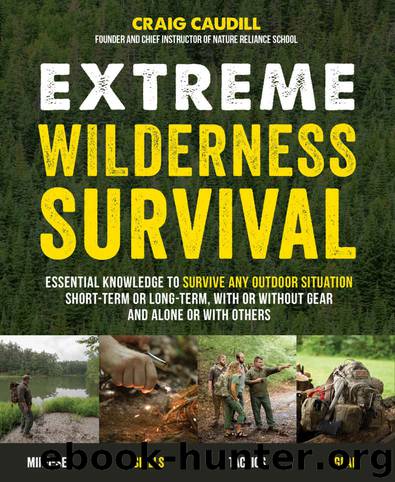Extreme Wilderness Survival: Essential Knowledge to Survive Any Outdoor Situation Short-Term or Long-Term, With or Without Gear and Alone or With Others by Caudill Craig

Author:Caudill, Craig [Caudill, Craig]
Language: eng
Format: epub
Publisher: Page Street Publishing
Published: 2017-03-20T16:00:00+00:00
WATERBORNE CONTAMINANTS
There are four main sources of waterborne threats that pose a problem to humans when they make their way into the human body:
PROTOZOAN: These are the most common contaminants. Giardia and cryptosporidium are the biggest culprits. Symptoms are diarrhea, stomach cramps, weight loss (in longer-term problems) and severe fatigue. The incubation period (how long protozoa take to start causing problems after entering the body) is quite varied. Giardia typically takes over a week to two weeks, whereas cryptosporidium can set up and cause issues within a few days.
VIRAL: These are another common type of contaminants that you can experience. These include Rotavirus, enterovirus and hepatitis A. You will notice a fever, fatigue, diarrhea, nausea and vomiting. Incubation times vary greatly and are dependent upon the particular virus. Some set up as quickly as one day, others may take a full month.
BACTERIAL: These are not very common. Bacteria, such as Salmonella and E. coli, are indicated by diarrhea, abdominal pain, nausea and vomiting. Depending upon your health and the amount of bacteria, you can start experiencing problems from one day to two weeks after taking them in.
CHEMICAL: There is no standardization of understanding of how chemical contaminants will affect us. Their origins are incredibly broad (such as agricultural runoff, industrial waste and human-waste runoff). This also includes far-reaching problems such as biological or nuclear fallout or their waste.
Unless you find yourself in a large metropolitan area, the easiest way to get clean water is to gather what falls from the sky. This includes dew, rain, snow and ice. These sources, along with condensation, can be considered clean and drinkable. The only issue is gathering it efficiently for your use.
Download
This site does not store any files on its server. We only index and link to content provided by other sites. Please contact the content providers to delete copyright contents if any and email us, we'll remove relevant links or contents immediately.
| Camping | Excursion Guides |
| Instructional | Walking |
In a Sunburned Country by Bill Bryson(3486)
Annapurna by Maurice Herzog(3425)
How to Read Nature by Tristan Gooley(3252)
Dangerous Girls by Haas Abigail(2981)
SAS Survival Handbook by John 'Lofty' Wiseman(2674)
The Lost Art of Reading Nature's Signs by Tristan Gooley(2625)
In the Woods by Tana French(2535)
The Stranger in the Woods by Michael Finkel(2458)
Food and Water in an Emergency by Food & Water In An Emergency(2344)
Guns, Germs and Steel by Diamond Jared(2304)
Everest the Cruel Way by Joe Tasker(2280)
Wild: From Lost to Found on the Pacific Crest Trail by Cheryl Strayed(2215)
Sea Survival Handbook by Keith Colwell(2199)
Backpacker the Complete Guide to Backpacking by Backpacker Magazine(2194)
Ultimate Navigation Manual by Lyle Brotherton(2130)
Trail Magic by Trevelyan Quest Edwards & Hazel Edwards(2127)
Welcome to the Goddamn Ice Cube by Blair Braverman(1993)
Birds of the Pacific Northwest by Shewey John; Blount Tim;(1926)
The Last Flight by Julie Clark(1911)
